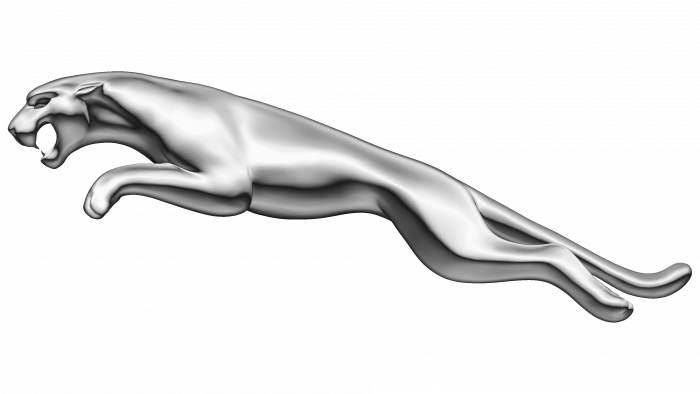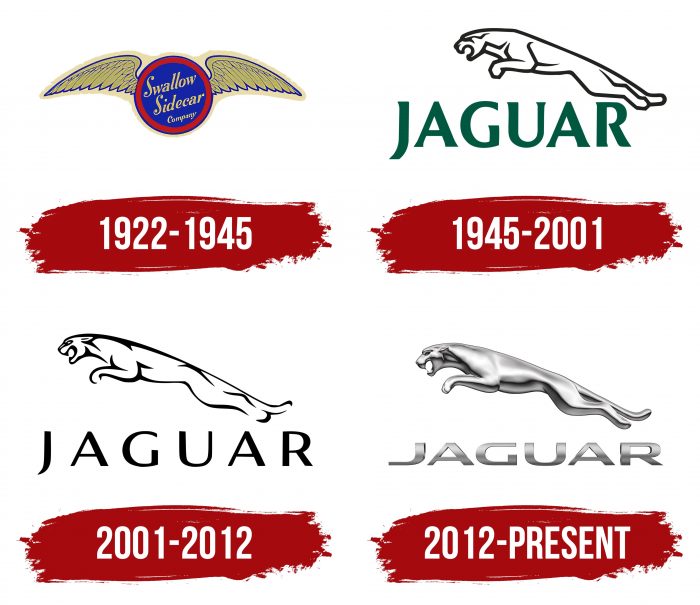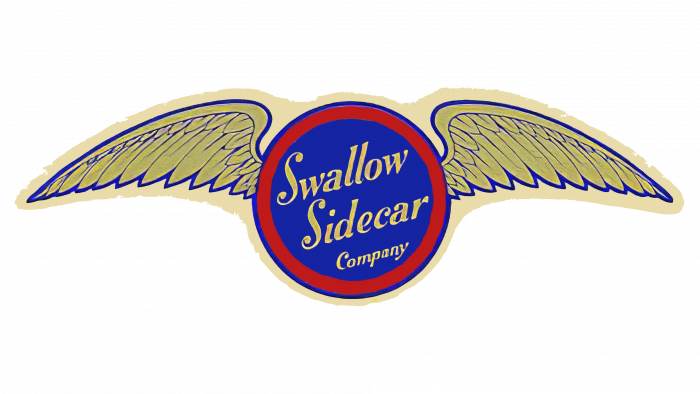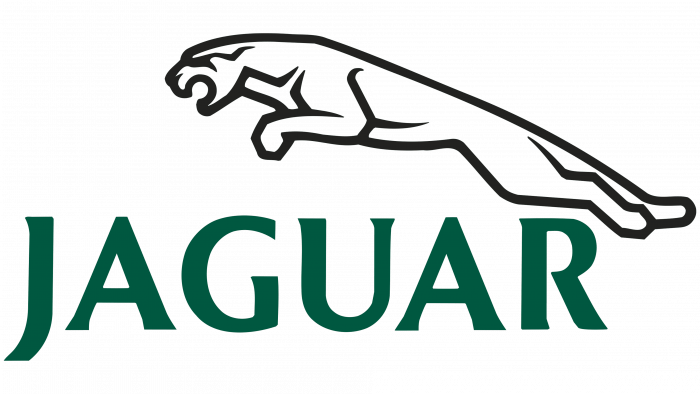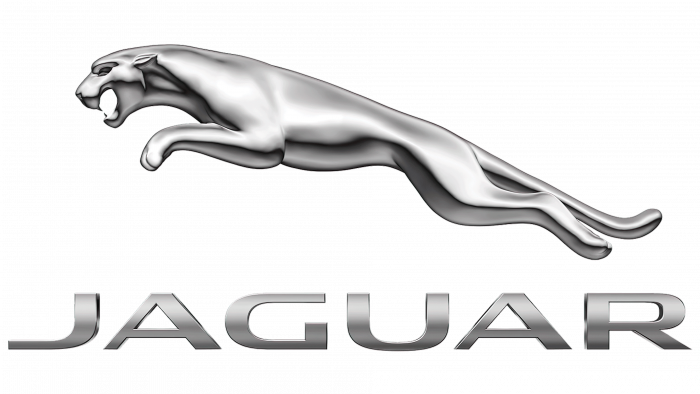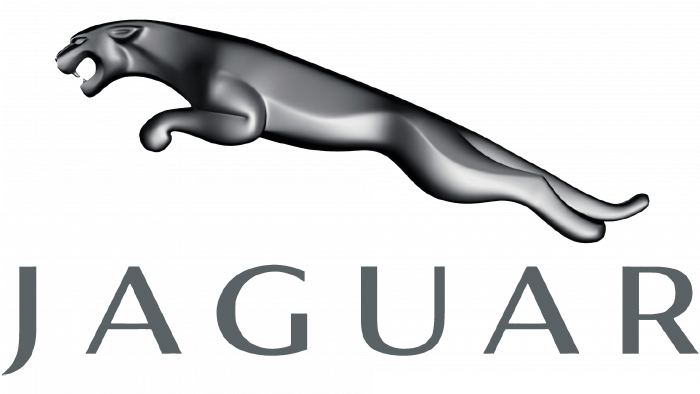Admiration and surprise arise when looking at the Jaguar logo. The brand’s cars are stylish and cool. The emblem promises a quick start, speed, and stamina—perfect for traveling without borders.
Jaguar: Brand overview
Meaning and History
William Lyons, the creator of SS Cars Limited, registered the name Jaguar Cars Ltd back in 1938, but that time did not come until 1945. In the post-war period, the abbreviation “SS” was associated with the Nazi organization of the same name, so a rebranding was decided at the shareholders’ meeting. Simultaneously, the line of cars became known as Jaguar without the prefix “SS” and changed its old abstract logo to a jumping predator’s image. This symbol was drawn from the bonnet mascot that appeared in 1938.
The first figurine was unsuccessful: William Lyons compared it to a cat driven off the fence. To create an “anatomically correct” version, the company owner entrusted the development of the radiator decoration to the sculptor Bill Rankin. The mascot was perfected by automotive illustrator Frederick Gordon Crosby and introduced in 1938. It also became the basis for most of Jaguar’s emblems.
What is Jaguar?
This brand has been part of the British holding Jaguar Land Rover Automotive PLC since 2013. But it appeared much earlier – back in 1935 when the manufacturer of motorcycle sidecars, Swallow Sidecar Company, introduced its first car called the Jaguar. It is planned that from 2025 only electric cars will be produced under this brand.
1922 – 1945
The company’s predecessor now owns the Jaguar brand. In the past, the Swallow Sidecar made motorized strollers. Its logo consisted of several parts: in the center was a blue circle with a red circular border and a yellow inscription “Swallow Sidecar Company,” along the edges were two bird wings with feathers.
1945 – 2001
In 1945, William Lyons renamed his business Jaguar Cars Ltd so that the “SS” acronym would not be reminiscent of World War II. Simultaneously, the emblem was adopted and received in the 1980s as the unofficial name The Leaper. Another version of her name is Leaping Jaguar. It was the profile of a bonnet mascot: the image of a predatory animal at the moment of a jump. The designers used only black (outline) and white (base) for illustration. At the bottom was the dark green JAGUAR lettering, made of caps with short and sharp serifs.
2001 – 2012
Ford Motor Company, which has owned the Jaguar brand since 1989, merged it with Land Rover in 2002 to form Jaguar Land Rover Limited. Then, she updated the logo and turned to The Partners for help. Designers studied many coats of arms to understand what heraldic animals look like. After that, a professional sculptor created a car mascot, making it more subtle, dynamic, and graceful. It was he who became the basis for the new emblem. The typeface has also changed: the grotesque has replaced the bold serif.
2012 – today
The current logo is essentially a scanned and 3D digitized Leaping Jaguar figurine. Its drop shadow and metal fill make the image look three-dimensional. The inscription is designed in the same style, with the letters compressed and stretched horizontally.
The company’s mascot is used only as an emblem and is no longer found on new cars’ hoods. This is due to a law passed by the European Union in 2005 to ensure pedestrian safety. However, the manufacturer continues placing the iconic symbol on the car’s grille, wheels, and rear, giving the Leaping Jaguar a flat shape. Sometimes, another icon is found on the grill: the head of a roaring jaguar inside a circle.
In any case, the animal stands for power, elegance, and grace. In the main logo, the predator prepares to leap rapidly, making the image dynamic. Elegant Jaguar vehicles best define speed.
Jaguar: Interesting Facts
Jaguar, the famous British luxury car brand, has a long tradition of design excellence and innovation. Since Tata Motors acquired it in 2008, Jaguar has kept evolving while preserving its rich heritage.
- Early Days: Jaguar started 1922 as the Swallow Sidecar Company, making motorcycle sidecars before shifting to cars.
- First Jaguar Cars: The brand’s first car, the 2.5-liter saloon launched in 1935, was admired for its beauty and performance. The “Jaguar” name was chosen to reflect elegance and power.
- Racing Success: Jaguar has a strong history in motorsport, especially with its victories at the 24 Hours of Le Mans in the 1950s with the C-Type and D-Type, celebrated for their innovative design and engineering.
- The Iconic E-Type: Introduced in 1961, it is one of the most famous sports cars, praised for its stunning looks and high performance. Even Enzo Ferrari called it “the most beautiful car in the world.”
- Engineering Breakthroughs: Jaguar has led in automotive engineering, introducing disc brakes in the 1950s and using aluminum to make cars lighter and faster.
- Joining Tata Motors: In 2008, Tata Motors of India bought Jaguar and Land Rover, giving Jaguar resources to grow and innovate, including making electric vehicles.
- Going Electric: The I-PACE, Jaguar’s first electric vehicle launched in 2018, has won several awards, showing Jaguar’s dedication to becoming a leader in electric cars.
- Luxury and Speed: Jaguar is known for luxury and performance. It offers sedans, sports cars, and SUVs, focusing on beautiful design and enjoyable driving.
- Electric Future: Jaguar plans to be an all-electric luxury brand by 2025, showing its commitment to sustainability and innovation.
- A Cultural Symbol: Jaguars have appeared in movies and TV shows, such as James Bond films and Mad Men, symbolizing style and sophistication.
Under Tata Motors, Jaguar represents luxury, performance, and sustainability. It is moving towards a future of electric vehicles while maintaining the elegance and innovation that have defined it for nearly 100 years.
Font and Colors
Until 2001, the company used a serif font known as Jaguar JC. Then she switched to a sans-serif typeface, opting for a modified version of the Optima. The author of the original version is Hermann Zapf. He created Optima in 1958, inspired by the inscriptions on the gravestones of the Renaissance era.
The current logo has a metallic fill, so the word “JAGUAR” is styled like the lettering on XJ vehicles. It is written in a proprietary font developed by the Fontsmith typography studio.
The dominant colors are gray and silver in different shades. Additional ones are white and black. The gradient gives the image plasticity and dynamism, making it look like the old Leaping Jaguar bonnet mascot. The cold palette creates the effect of a metallic sheen and is associated with luxury, nobility, and modernity.
FAQ
What does the Jaguar symbol mean?
The symbol features a jungle cat, reflecting the brand’s focus on performance and luxury. The Leaping Jaguar emblem is a sleek silver cat jumping with a snarling face. This pose demonstrates the brand’s commitment to agility, speed, and forward motion. It represents movement and power, keeping with the company’s reputation as a manufacturer of high-performance vehicles.
What animal is the Jaguar logo?
The Leaping Jaguar logo features a jaguar cat. This symbol depicts a silver jaguar in a leap with a growl on its face. It was first used as a hood decoration and is now a 2D icon in silver, metallic grey, and black. The Leaping Jaguar symbolizes the brand’s emphasis on agility, power, and forward motion. The dynamic stance reflects the company’s commitment to performance and elegance in its vehicles.
Does Jaguar have two logos?
Yes, the brand has two logos. The first is the Jaguar Leaper. It depicts a silver jaguar cat in mid-leap with a snarling face, representing agility, strength, and forward momentum. Originally a hood adornment, the logo now features a 2D badge in silver, metallic gray, and black.
The second logo is the Jaguar Growler. This emblem depicts the face of a snarling jaguar, emphasizing the strength and ferocious character of the brand’s cars. Both logos feature the jaguar, one of the strongest big cats, and reflect the brand’s performance, elegance, and power values.
When did Jaguar change their logo?
The brand has updated its logo several times. The name “Jaguar” was first added in 1935. Older models featured leaping jaguar logos and a snarling face badge on a red and silver background.
The current jumping jaguar logo was introduced in 1945. It depicts a sleek silver jaguar cat in mid-leap, symbolizing agility, strength, and forward movement. The emblem has changed from a hood ornament to a 2D badge on modern cars.
What does the Jaguar logo represent?
The logo depicts a jumping jaguar, symbolizing speed—a key characteristic of the brand’s cars. It represents speed, strength, endurance, and superiority. These qualities show the brand’s confidence and dominance on the road. The emblem signifies that the brand’s vehicles are built for performance and stand up well to the competition. The Leaping Jaguar reflects the brand’s commitment to producing powerful, agile, durable vehicles.
Why did Jaguar change its logo?
The company changed its logo to honor the original radiator figurine, which was banned due to pedestrian safety concerns. The brand transformed the mascot’s silhouette into a three-dimensional image, maintaining its proportions and silvery shine. This update allowed the brand to retain the iconic leaping jaguar while adhering to safety standards. The new logo retains the elegance and power of the original design.
